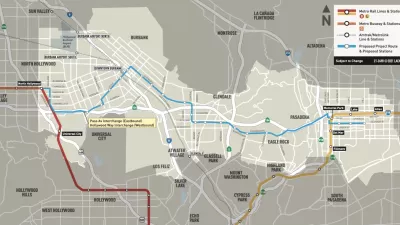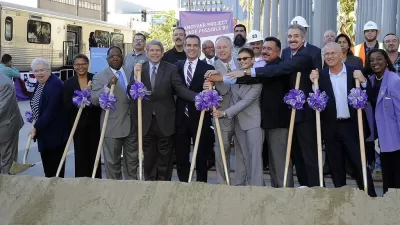Similar to microtransit on demand programs in other cities, Los Angeles' ongoing experiment is proving to be very expensive (for the public) for the benefit of very few riders.
"A half-year into Metro and Via’s year-long 'Mobility on Demand' pilot shows that ride-hail continues to be an expensive way to provide mobility for very few riders," reports Joe Linton.
The Via pilot launched in January 2019, with funding assistance from the federal government, offering on-demand, fixed-price ride-hailing services in the hopes of providing first-last mile connections to and from several specific stations in the Los Angeles County Metropolitan Transportation Authority system.
"Last month, Metro released its five-page second quarter update report showing the latest statistics for the transit-on-demand pilot," according to Linton. While ridership with the program is growing, thanks to expensive efforts to grow ridership, "total ridership is still dismal," writes Linton.
"With a $1.75 million Metro expenditure for one year – 260 weekdays in that year, Metro is spending $6,730 per day for these rides. 1,675 rides per week translates to 335 rides per day. 335 rides for $6,730 means that each ride is costing Metro $20.09 (that is just Metro’s cost – these also cost FTA and forgo Via’s “risk sharing”)."
FULL STORY: Six Months in, Metro/Via Mobility on Demand Pilot is an Expensive Flop

Maui's Vacation Rental Debate Turns Ugly
Verbal attacks, misinformation campaigns and fistfights plague a high-stakes debate to convert thousands of vacation rentals into long-term housing.

Planetizen Federal Action Tracker
A weekly monitor of how Trump’s orders and actions are impacting planners and planning in America.

In Urban Planning, AI Prompting Could be the New Design Thinking
Creativity has long been key to great urban design. What if we see AI as our new creative partner?

King County Supportive Housing Program Offers Hope for Unhoused Residents
The county is taking a ‘Housing First’ approach that prioritizes getting people into housing, then offering wraparound supportive services.

Researchers Use AI to Get Clearer Picture of US Housing
Analysts are using artificial intelligence to supercharge their research by allowing them to comb through data faster. Though these AI tools can be error prone, they save time and housing researchers are optimistic about the future.

Making Shared Micromobility More Inclusive
Cities and shared mobility system operators can do more to include people with disabilities in planning and operations, per a new report.
Urban Design for Planners 1: Software Tools
This six-course series explores essential urban design concepts using open source software and equips planners with the tools they need to participate fully in the urban design process.
Planning for Universal Design
Learn the tools for implementing Universal Design in planning regulations.
planning NEXT
Appalachian Highlands Housing Partners
Gallatin County Department of Planning & Community Development
Mpact (founded as Rail~Volution)
City of Camden Redevelopment Agency
City of Astoria
City of Portland
City of Laramie




























